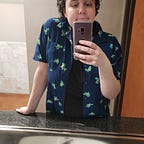Taylor Swift’s “Fearless” Is a Lot Gayer Than I Remembered
The re-recording of her 2008 album reminded me of the queer themes of many of her early song lyrics.
I know I’m far from the only queer person who has been jamming out to Fearless (Taylor’s Version) on repeat since it was released on April 9th.
This album is a re-recorded, expanded version of Taylor Swift’s sophomore album, Fearless, that came out in 2008. After industry mogul Scooter Braun acquired the master recordings of Swift’s Big Machine discography, she announced that she would be re-recording her first six albums.
Some may view this as a shameless cash grab, but as someone who has been a Swiftie for more than a decade, I’m always happy to get more Taylor Swift content.
She has released three albums within the last two years (Lover, folklore, and evermore) that have all been getting plenty of playtime from me. But it has been a while since I’ve listened closely to some of the lyrics of her early records, particularly Fearless.
I’d forgotten just how…gay some of those songs are.
(Disclaimer: I’m not trying to define Taylor Swift’s sexual orientation one way or the other. I’m just exploring some of the queer themes that are common in her early songwriting, particularly on Fearless.)
You Belong With Me
This was the first Taylor Swift song I remember hearing. I couldn't escape it when I was in sixth grade; girls around me would sing it constantly. I thought the song was catchy, so I downloaded the rest of the album on LimeWire (how mid-aughts of me) and found myself really enjoying it.
However, I thought I was a cisgender heterosexual girl at the time, so I didn’t pick up on any of the queer-coded lyrics. But there is no shortage of them in “You Belong With Me.”
The song describes being in love with your best friend who’s currently dating someone ill-suited for them. The speaker laments that if only the love interest would wake up and see that the two of them are meant for each other, they could both be so happy.
Sure, the “other person” in this song is specifically described as a girl, but if the gender pronouns were flipped, this would be a classic example of a gay teenager being hopelessly in love with their best friend.
Love Story
This song was also absolutely everywhere when I was in middle school. It describes two people in a relationship that everyone around them would disapprove of. They literally sneak out to the garden to see each other, keeping quiet because they’d be dead if other people knew. People are trying to tell them how to feel. Sounds a lot like homophobes telling queer people that their romantic feelings aren’t real, that they shouldn't be feeling them (or that it’s just a phase).
Swift compares these characters to Romeo and Juliet —arguably the most famous love story in English literature. Except, she changes the tragic ending to one wherein the speaker’s father approves of their relationship and helps them get married.
Maybe this choice was meant to signal how queer people were gradually becoming more accepted among mainstream Americans around this time. How things were starting to get better for us.
Of course, I can’t say that for sure. But that’s just the vibe I get from listening to this song now.
The Way I Loved You
“The Way I Loved You” is the very definition of compulsory heterosexuality — a girl is dating a supposedly “perfect” guy, yet she feels absolutely nothing for him. She misses the emotional roller coaster that happened with her previous love interest.
Now, there’s nothing specific in the lyrics to indicate that this person was a girl, but I just get that feeling, ya know?
Hey Stephen
Yes, Swift is addressing someone with a male name. But she may have just shoehorned that in there like she did on her first album (Drew in “Teardrops on My Guitar” and Corey in “Stay Beautiful”).
Her singing that she just can’t help falling for “Stephen” just gives off major queer vibes to me. Sometimes, when you have a gay crush, you try to shove those feelings down, but in the end, you just can’t help yourself.
I know that many queer people have criticized Swift for her shallow-seeming public support for the LGBTQ+ community (for instance, comparing the actual oppression queer folks face with the “shade” she’s gotten on Twitter in Lover’s “You Need to Calm Down”).
But what they might be forgetting is that she likely could not come out even if she wanted to. She’s a global superstar. As far as gay acceptance has come in many countries, she would be banned in others if she were to publicly come out (if she were queer, which she may very well not be). As much as she tries to make us believe she’s totally in control of her public image, she most likely has an entire team of professional marketers and PR experts in charge of her public perception.
Whatever Taylor Swift’s sexual orientation might be, there’s no denying the queer themes threaded throughout her discography. Even if most of her songs weren't straight-up bops, I and many other fans would still enjoy them for that reason.
